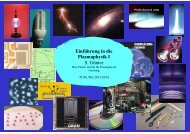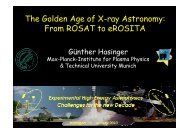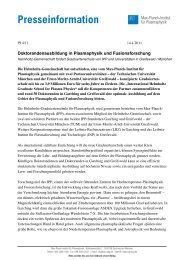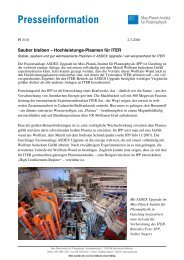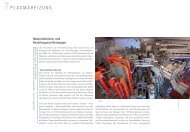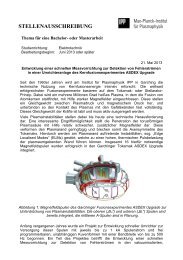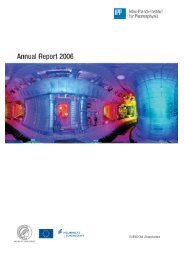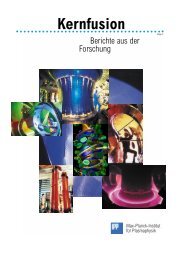ASDEX Upgrade - Max-Planck-Institut für Plasmaphysik
ASDEX Upgrade - Max-Planck-Institut für Plasmaphysik
ASDEX Upgrade - Max-Planck-Institut für Plasmaphysik
You also want an ePaper? Increase the reach of your titles
YUMPU automatically turns print PDFs into web optimized ePapers that Google loves.
Letter No.<br />
<strong>ASDEX</strong> <strong>Upgrade</strong><br />
11/April 2010<br />
Foreword<br />
With this issue of the <strong>ASDEX</strong> <strong>Upgrade</strong> letter, we are<br />
pleased to give an overview of our present shutdown activities<br />
as well as our plans for the coming campaign, which<br />
is scheduled to begin in autumn 2010. During this shutdown<br />
period significant upgrades are being made to the<br />
<strong>ASDEX</strong> <strong>Upgrade</strong> tokamak. For example, the first set of invessel<br />
coils is presently being installed and the ECRH system<br />
is being expanded. These upgrades will, to a large<br />
extent, drive the scientific programme of the next campaign,<br />
which will be organized by our new Task Force<br />
Leaders. Additionally, one of the ICRF antennas is being<br />
modified in an attempt to reduce the high-Z impurity influx<br />
from active antennae limiters. In the next campaign<br />
we will be able to asses the success of this modification and<br />
thus the proposed strategy to cure this problem.<br />
Another major asset for the coming campaign will be the<br />
availability of the EZ4 generator, which has been back in<br />
operation since autumn 2009. This additional power will<br />
help us to further enlarge the operational space of the<br />
all-W <strong>ASDEX</strong> <strong>Upgrade</strong>. On this front we are optimistic<br />
since at the end of the 2009 campaign we already achieved<br />
new, record values of P/R; a topic which will be expounded<br />
upon in this letter.<br />
While <strong>ASDEX</strong> <strong>Upgrade</strong> will continue to characterize the<br />
compatibility of ITER relevant scenarios with a metal<br />
wall, we also look forward to the start of JET operation<br />
with the ITER-like wall in 2011, where our operational<br />
expertise is being used to prepare this important step on<br />
the European stepladder. Together, these two machines<br />
should be able to provide a solid basis for the first wall<br />
material strategy in ITER and, looking to the future,<br />
also for DEMO.<br />
Hartmut Zohm
Highlight<br />
from a recent <strong>ASDEX</strong> <strong>Upgrade</strong> experiment<br />
Record P / R values reached in the all-W AUG<br />
Dissipation of the plasma heating<br />
power P is a formidable problem for<br />
fusion reactors. The power to be handled<br />
in future machines like ITER<br />
and DEMO will reach values of P / R<br />
between 20 and 50 MW/m, which is<br />
significantly higher than in most present<br />
day machines. Here, R is the major<br />
radius of the device and the ratio<br />
P / R is believed to be the relevant<br />
quantity for the characterisation of<br />
the power exhaust problem. The radiation<br />
of a substantial power fraction<br />
in the plasma edge and in the divertor<br />
by impurity radiation is the main concept<br />
being considered to reduce the<br />
power flux on the divertor tiles down<br />
to technically feasible values. With increasing<br />
heating power more and<br />
more power has to be radiated in the<br />
volume at the plasma edge and in the<br />
divertor. Unfortunately, this volume<br />
has the tendency to become smaller<br />
with higher edge temperatures.<br />
Therefore, the demonstration of discharges<br />
with high levels of edge and<br />
divertor radiation at high input power<br />
is of the utmost importance for the<br />
preparation of ITER and DEMO operation.<br />
At the end of the 2009 AUG<br />
campaign a total heating power of<br />
close to 20 MW (P/R = 12) was applied<br />
to a standard H-mode discharge<br />
(see fig. 1). This is a record value for<br />
AUG after the installation of its alltungsten<br />
wall. In order to protect the<br />
divertor from excessive heat loads<br />
deuterium and nitrogen were puffed.<br />
The puff-rate of the latter was feedback-controlled<br />
by the signal T div<br />
,<br />
which is closely related to the divertor<br />
temperature and thus to the target<br />
power load. When the heating power<br />
is ramped-up, more nitrogen is needed<br />
to keep the divertor temperature,<br />
T div<br />
, at its preset value (see fig. 1). The<br />
normalized energy confinement stays<br />
close to H-Mode confinement, the<br />
concentration of tungsten does not<br />
exceed 2 . 10 -5 even in the phase with<br />
the highest power, and Z eff<br />
remains<br />
throughout the discharge, below 2.<br />
Fig. 1: Time-traces of AUG discharge #25844 (1.2 MA/2.5 T, low triangularity shape) for heating<br />
power, gas puff rate, H-factor and temperature T div<br />
in the outer divertor.<br />
Discharges of this type will be the target<br />
of much more detailed investigations<br />
during future campaigns, in<br />
which ITER relevant P/R values of<br />
close to 20 will become possible once<br />
the current ECRH upgrade is finished<br />
and ICRH is back to full performance<br />
with antennas that are<br />
compatible with the all-W AUG wall.
Shutdown Activities<br />
& Outlook to the<br />
2010 Campaign<br />
Currently, AUG is in a shutdown phase that is devoted to<br />
two major alterations:<br />
(i) In AUG a highly flexible, active set of 3x8 in-vessel<br />
saddle coils will be installed in a stepwise manner. These<br />
coils will be capable of producing non-axisymmetric<br />
error fields with toroidal mode numbers up to n=4. Such<br />
a system is foreseen for ITER with a coil geometry<br />
very similar to that chosen for AUG. In the first step,<br />
which is currently being implemented, 4 coils above and<br />
4 coils below the midplane will be installed, allowing a<br />
field structure up to n=2 with odd or even poloidal parity.<br />
These coils will have DC power supplies and can be<br />
used to produce error fields for ELM control, disruption<br />
mitigation and other experimental applications.<br />
(ii) The ECRH-II system is currently undergoing an upgrade<br />
to a total available power of 4 MW (in 2011) operating<br />
at 2 frequencies (105 and 140 GHz). This system<br />
allows for strong electron heating and, together with the<br />
installed fast steerable antennae, the study of the avoidance<br />
of impurity accumulation by central heating, feedback<br />
control of performance limiting NTMs, disruption<br />
avoidance and also support for the CTS diagnostic. In<br />
addition, q-profile shaping via the application of ECCD<br />
will become possible for the development of Hybrid and<br />
AT scenarios. From the very start of the 2010 campaign,<br />
three 1 MW/10s gyrotrons are expected to be available.<br />
The start of the 2010 campaign is foreseen for September<br />
2010. Most likely it will continue into 2011 and presumably,<br />
operation will stop at the end of February 2011 to allow the<br />
installation of the next 8 internal coils. The process of<br />
preparing the 2010 AUG scientific programme began in<br />
the end of March 2010 with an open call for participation.<br />
The programme is organized into five Task Forces (TF):<br />
• Improvement of H-mode and integrated scenarios<br />
• Pedestal physics including tolerable ELMs<br />
• SOL & Divertor physics and first wall materials<br />
• MHD instabilities and their active control<br />
• Transport<br />
The TF IV ‘MHD instabilities and their active control’ will<br />
be lead by a scientist from FZ-Jülich. The management of<br />
AUG Task Forces by non-IPP scientists for periods of two<br />
years has been a tradition since 2004 and demonstrates the<br />
successful integration of external collaborators, in partic -<br />
ular from European Associations, into the AUG programme.<br />
Fig. 2: Contour plots of Re (E ||<br />
) for the current AUG 2-strap antenna (left);<br />
and for an modified design of a 2-strap antenna with broad limiters and<br />
reduced E ||<br />
fields (right).<br />
A modified antenna to<br />
test the design approach<br />
for improved ICRF<br />
operation in the all-W AUG<br />
The performance of the ICRH in the all-W AUG is considerably<br />
poorer than it was when AUG was a low-Z<br />
walled machine. Although ICRH was very useful during<br />
AUG’s transition phase from a carbon to a W machine as<br />
a central heating method to avoid density peaking and impurity<br />
accumulation, the use of ICRF heating is now hampered<br />
by ICRF-related impurity sources produced at the<br />
W-coated plasma facing components close to the antennas.<br />
Since the installation of W-coated antenna limiters, ICRF<br />
heating is accompanied by a strong W release, which obliterates<br />
the beneficial effect of the central heating. This impurity<br />
release is thought to be produced by the acceleration<br />
of light impurity ions along magnetic field lines in the rectified<br />
electric antenna near-fields (E ||<br />
). Although this W<br />
source can be reduced by increasing the antenna to plasma<br />
distance or by a higher gas puff rate, the ICRF antenna<br />
itself needs to be optimized in order to demonstrate the<br />
compatibility of ICRF with a high-Z wall in a tokamak.<br />
The optimization involves reducing the parallel electric<br />
fields (E ||<br />
) near the antenna, which can be calculated with<br />
a commercial code (HFSS, High Frequency Structure<br />
Simulator). To test this approach a cost effective antenna<br />
modification, with only modest hardware changes, will be<br />
installed in one of the four ICRF antennas (antenna 4, sector<br />
12) during the present shutdown. The design with lower<br />
E ||<br />
values is shown in figure 2 (r.h.s.) together with the<br />
current AUG ICRF antenna (l.h.s.) for reference. The<br />
modifications concern mainly the limiters (considerably
oader), and the antenna straps (narrower). The calculated<br />
reduction of E ||<br />
is roughly a factor 2 (see fig. 3). Experi ments<br />
in the coming 2010 AUG campaign will characterize the<br />
performance of this modified antenna. Experiments which<br />
show a reduction of the W source during ICRF heating<br />
would validate the applied modelling approach. The same<br />
approach could then be used for designing advanced antennas<br />
with more significant reductions of E ||<br />
.<br />
Fig 3: Voltage obtained<br />
by integrating the electric<br />
field along the field<br />
lines passing in front of<br />
the antenna as a func -<br />
tion of the ordinate z<br />
of the field line at the<br />
middle of the antenna.<br />
Re-integration of flywheel-generator EZ4<br />
into the AUG power supply system<br />
Fig. 4: Repaired rotor of flywheel generator EZ4 (220 MVA / 650 MJ, 160 tons).<br />
In April 2006 an incident with the flywheel<br />
generator EZ4 led to serious<br />
damage of the device (AUG letter<br />
No. 9). EZ4 is one of three generators<br />
used on AUG to supply the ohmic<br />
trans former as well as the poloidal<br />
field coils and additional heating systems.<br />
This incident with EZ4 gave rise<br />
to the need of a safety review of all<br />
three generators. Based on recommend<br />
ations from external experts<br />
many improvements in the control,<br />
instrumentation, protection, and the<br />
auxiliary systems of the flywheel-generators<br />
were made. These improvements<br />
were done in parallel to the<br />
repair of the EZ4 rotor and the reconstruction<br />
of the stator at SIEMENS<br />
Dynamowerk, Berlin. Additional<br />
electrical braking systems were im-<br />
plemented for the EZ2 and EZ3 generators.<br />
Furthermore, the electrical<br />
supply of the EZ4 oil lubrication<br />
pumps has been improved. It includes<br />
now one DC-pump with its own battery,<br />
which extends the emptying time<br />
of the top oil tank to 30 minutes. An<br />
<strong>ASDEX</strong> <strong>Upgrade</strong> Letter<br />
published by<br />
<strong>Max</strong>-<strong>Planck</strong>-<strong>Institut</strong> <strong>für</strong> <strong>Plasmaphysik</strong><br />
Association Euratom-IPP<br />
Boltzmannstraße 2<br />
D-85748 Garching<br />
PDF copy of letter available at:<br />
additional future safety measure is<br />
the installation of a mechanical brake<br />
for EZ4, which will be commissioned<br />
in early 2011. It consists of a 7 MW hydraulic<br />
dynamometer and a 40 kNm<br />
disc-brake. The required water cooling<br />
system, including a 15 m 3 tank for<br />
storing 1800 MJ of energy and the 15<br />
tonnes support structure for the braking<br />
unit, are being installed during the<br />
2010 shutdown. Also, the technical basis<br />
for the control of all flywheel generators<br />
from a single room has been<br />
established. This data acquisition and<br />
visualisation centre will help to identify<br />
emerging faults earlier and to react<br />
faster and more efficiently in cases<br />
of operational problems.<br />
Since October 2009 AUG has made use<br />
of its full generator capability, which<br />
extends the AUG operational space<br />
towards longer pulse lengths, more<br />
heat ing power (see highlight of this<br />
let ter) and more highly shaped plasmas.<br />
Coordination Prof. Dr. Hartmut Zohm<br />
Contact<br />
Dr. Josef Schweinzer<br />
Phone +49/89/3299 22 05<br />
Fax +49/89/3299 25 80<br />
josef.schweinzer@ipp.mpg.de<br />
www.ipp.mpg.de<br />
http://www.ipp.mpg.de/ippcms/eng/for/publikationen/letters/download/aug_letter_4_10.pdf



